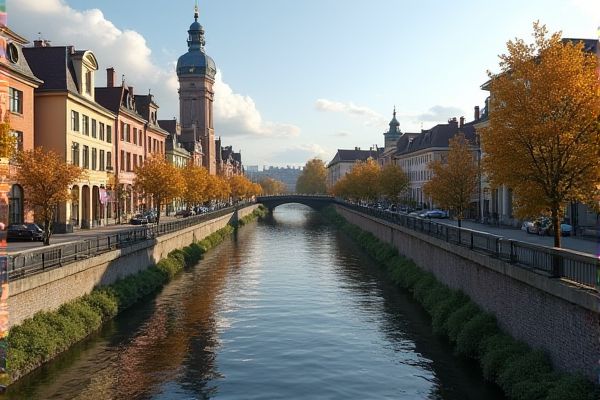
Dining and food culture in Germany: Hearty meat-centric dishes. Popular sausages: Bratwurst, Currywurst. Bread variety is extensive. Sauerkraut commonly served. Beer culture is significant. Traditional dinner: Abendbrot. Coffee and cake: afternoon tradition. Slow food movement growing. Cash preferred in many restaurants. Tip included, but small extras common.
Hearty meat-centric dishes.
German cuisine is characterized by hearty, meat-centric dishes such as bratwurst, schnitzel, and sauerbraten. These dishes often feature pork, beef, and poultry, accompanied by potatoes, cabbage, and root vegetables, and are known for their robust and sometimes tangy flavors. To learn more about this hearty cuisine, visit the German Cuisine glossary. Experience the rich flavors that define traditional German meals, balancing savory meats with the comforting taste of classic side dishes.
Popular sausages: Bratwurst, Currywurst.
Bratwurst, the most popular German sausage, is made from ground pork and various spices, often served with mustard and kraut on a bun, especially during Oktoberfest. A notable variation is Currywurst, a fast food dish invented in 1949 by Herta Heuwer. It features a grilled or fried bratwurst sausage sliced and covered in curry ketchup, commonly accompanied by chips or bread rolls. To explore more about the rich heritage of these culinary delights, visit the History of the German Sausage page.
Bread variety is extensive.
German cuisine boasts an extensive variety of bread, with around 3,000 types of breads and 1,200 different types of pastries and rolls produced in approximately 13,000 bakeries, utilizing a wide range of grains including wheat, rye, barley, spelt, oats, and more. These breads are often made with sourdough and whole grain for high fiber content, reflecting the rich traditions and cultural significance of baking in Germany. For more detailed insights into this culinary heritage, visit the comprehensive entry on German Cuisine on Wikipedia, which explores the diverse flavors and regional specialties that define this celebrated aspect of German culture.
Sauerkraut commonly served.
Sauerkraut in German cuisine is commonly served as a side dish, often braised with seasonings, bacon, onions, and sometimes apples, and is typically accompanied by dishes like German bratwurst, boiled potatoes, or pork. It is a traditional and healthy food, rich in vitamins C and K, and is valued for its probiotic properties and distinctive sour flavor. To learn more about its authentic preparation, visit the Authentic German Sauerkraut Recipe for detailed instructions and insights into making this classic dish.
Beer culture is significant.
Beer culture is deeply ingrained in German society, with beer being the country's favorite alcoholic beverage, consumed at an average of 95 liters per person in 2020. Germany boasts over 5,000 types of beer produced by around 1,500 breweries, and the German Purity Law of 1516 ensures that beer is made only from water, malt, hops, and yeast, making it a central part of German culture and traditions. Dive deeper into this rich heritage by exploring the German Beer History and its continued influence in shaping German identity today.
Traditional dinner: Abendbrot.
Abendbrot, or "evening bread," is a traditional German cold dinner typically eaten between 6:00 p.m. and 8:00 p.m., consisting of bread, cheese, ham, and vegetables, where everyone assembles their own open-faced sandwiches. It is a low-effort meal that allows for a variety of toppings and is often preferred after a hearty lunch. To explore more about the elements of this cultural meal and other aspects of the German Food Culture, visit the Fintiba website. Emphasizing simplicity and communal dining, Abendbrot remains a staple in German households.
Coffee and cake: afternoon tradition.
In Germany, "Kaffee und Kuchen" is an afternoon tradition where friends, family, or coworkers gather to enjoy coffee, a variety of cakes and pastries, and socialize, often in cafes or at home, with no set rules or formalities. This ritual typically occurs in the late afternoon and features a range of cakes such as apple strudel, Black Forest cherry cake, and seasonal fruit cakes, accompanied by various coffee drinks. To learn more about this delightful tradition and its cultural significance, you can explore the detailed overview provided by the Kaffee und Kuchen Tradition page.
Slow food movement growing.
The Slow Food movement in Germany is characterized by a strong emphasis on solidarity, mutual support, and the promotion of local, regional food systems. With initiatives such as food coops, buying groups, and support for small-scale farmers, the movement aims to counter the impacts of the globalized industrial food system. For more information on these impactful initiatives, you can visit the Slow Food website, which details how these efforts contribute to a sustainable and equitable food environment.
Cash preferred in many restaurants.
In Germany, many small businesses, bars, and restaurants, including some cafes and local eateries, prefer or only accept cash payments, with debit cards like Girocard being the next most accepted form of payment, especially in smaller establishments. For more detailed insights on this cultural aspect, you can visit Cash is King, a blog that explores these nuances in depth.
Tip included, but small extras common.
In Germany, tipping is optional but common as a small extra; in restaurants, people often round up the bill by 1-2 EUR or tip around 5-10% of the total, and it is advisable to tip in cash rather than by card. For more detailed guidance on this cultural practice, you can refer to the comprehensive insights provided by All About Berlin. Understanding such nuances can enhance your dining experiences in Germany and ensure that you conform to local customs when it comes to tipping.
